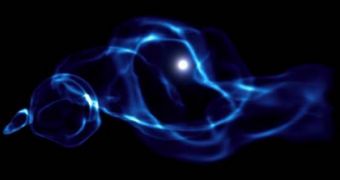Scientists at the SLAC National Accelerator Laboratory have recently completed running numerous simulations of how the earliest black holes that appeared in the Universe may have looked like, and how they could have influenced the development of other forms of matter. Their investigation revealed that the structures would have caused incredible mayhem in their surroundings, in spite of the fact that they were relatively small by today's standards. Additionally, the models indicated that the black holes grew very slowly, ScienceDaily informs.
In charge of the new study were astrophysicists Marcelo Alvarez and Tom Abel, both from the Kavli Institute for Particle Astrophysics and Cosmology (KIPAC), jointly located within the US Department of Energy-operated SLAC and the Stanford University. Former KIPAC expert John Wise, now with the NASA Goddard Space Flight Center, also contributed to the achievement. Details of the research, published in the latest issue of The Astrophysical Journal Letters, also question established knowledge, which holds that the first black holes were giants, gorging themselves on clouds of dust and gas.
Other researchers inferred that there would have been nothing to stop their growth, and that the earliest black holes undoubtedly evolved into the supermassive giants that still lurk at the core of the largest galaxies in the Universe. However, the new simulations seem to render this hypothesis obsolete. According to the SLAC team, the role that the earliest black holes played was far more important and complex than that.
“I'm thrilled that we now can do calculations that start to capture the most relevant physics, and we can show which ideas work and which don't. In the next decade, using calculations like this one, we will settle some of the most important issues related to the role of black holes in the Universe,” Abel says. The team believes that large amounts of X-rays may have been responsible for hindering the early growth of black holes.
“While X-rays from matter falling onto the first black holes hindered their further growth, that very same radiation may have later cleared the way for direct formation of supermassive black holes by suppressing star formation. However, a lot of work remains to be done to test whether this idea will actually pan out; this is really just the tip of the iceberg in terms of realistic simulations of black holes in the early universe,” argues Alvarez. “This work will likely make people rethink how the radiation from these black holes affected the surrounding environment. Black holes are not just dead pieces of matter; they actually affect other parts of the galaxy,” Wise concludes.

 14 DAY TRIAL //
14 DAY TRIAL //